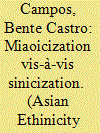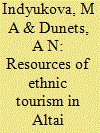| Srl | Item |
| 1 |
ID:
141161


|
|
|
|
|
| Summary/Abstract |
This article studies the Miao classification as an example to examine the minzu shibie project initiated by the Chinese Communist Party after 1949. The Miao classification that originates with the minzu shibie project can be defined as a process of miaoicization; however, it is not a unified Miao group (as projected by the classification team) that has emerged but rather one dominant Miao subgroup that defines the official Miao category in contemporary China. At the moment the most dominant Miao subgroup is the Hmu group in Southeast Guizhou. The overemphasis of Hmu sub-culture to represent all the Miao of China is related to the fact that over the last decades many important leaders in Guizhou have been Hmu. While all Hmu are sinicized to a certain extent, it seems that the Hmu at the bottom of the socioeconomic scale are most likely to be sinicized and to amalgamate with the Han majority.
|
|
|
|
|
|
|
|
|
|
|
|
|
|
|
|
| 2 |
ID:
095359


|
|
|
|
|
| Publication |
2010.
|
| Summary/Abstract |
Picture postcards were an important element of Japanese imperial propaganda, though they have yet to receive the scholarly attention they deserve. This paper argues that the Taiwan Government-General played an active role in the production and dissemination of picture postcards to propagate a particular view of life in the 'Aborigine Territory'. To promote ethnic tourism in the wake of the bloody 1930 Wushe Uprising, and to construct Taiwan's majority Han population as 'inauthentic' as part of a wider ideological offensive against China, Japanese colonial postcards portrayed Taiwan Indigenous Peoples as isolated, culturally intact, and indebted to a benevolent state. The most widely circulated picture-postcard images of Taiwan Indigenous Peoples were produced by a coterie that included photographer Segawa K?kichi, publisher Katsuyama Yoshisaku, watercolorist Lan Yinding and Aborigine Affairs Chief Suzuki Hideo. The documentary traces they left behind reveal a series of cross-cutting social and professional ties that bound them together as an 'interpretive community'. Their location in centers of colonial culture, commerce, and government, along with the internal consistency of their vision, well positioned them to not only peddle postcards, but to sell an empire.
|
|
|
|
|
|
|
|
|
|
|
|
|
|
|
|
| 3 |
ID:
138531


|
|
|